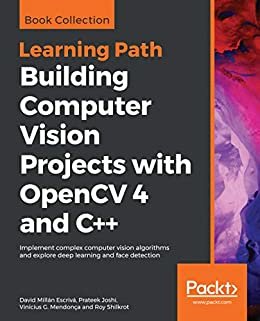
Building Computer Vision Projects with OpenCV 4 and C++: Implement complex computer vision algorithms and explore deep learning and face detection (English Edition)
- 作者
- David Millán Escrivá、Prateek Joshi、Vinícius G. Mendonça、Roy Shilkrot
- 语言
- 英语
- 出版社
- Packt Publishing 版次:1
- 出版日期
- 2019年3月26日
- 纸书页数
- 540页
- 电子书格式
- epub,pdf,mobi,azw3,txt,fb2,djvu
- 文件大小
- 69539 KB
- 下载次数
- 877
- 更新日期
- 2023-05-20
- 运行环境
- PC/Windows/Linux/Mac/IOS/iPhone/iPad/iBooks/Kindle/Android/安卓/平板
内容简介
Delve into practical computer vision and image processing projects and get up to speed with advanced object detection techniques and machine learning algorithms
Key Features
Discover best practices for engineering and maintaining OpenCV projects
Explore important deep learning tools for image classification
Understand basic image matrix formats and filters
Book Description
OpenCV is one of the best open source libraries available and can help you focus on constructing complete projects on image processing, motion detection, and image segmentation.
This Learning Path is your guide to understanding OpenCV concepts and algorithms through real-world examples and activities. Through various projects, you'll also discover how to use complex computer vision and machine learning algorithms and face detection to extract the maximum amount of information from images and videos. In later chapters, you'll learn to enhance your videos and images with optical flow analysis and background subtraction. Sections in the Learning Path will help you get to grips with text segmentation and recognition, in addition to guiding you through the basics of the new and improved deep learning modules. By the end of this Learning Path, you will have mastered commonly used computer vision techniques to build OpenCV projects from scratch. This Learning Path includes content from the following Packt books:
Mastering OpenCV 4 - Third Edition by Roy Shilkrot and David Millán Escrivá
Learn OpenCV 4 By Building Projects - Second Edition by David Millán Escrivá, Vinícius G. Mendonça, and Prateek Joshi
What you will learn
Stay up-to-date with algorithmic design approaches for complex computer vision tasks
Work with OpenCV's most up-to-date API through various projects
Understand 3D scene reconstruction and Structure from Motion (SfM)
Study camera calibration and overlay augmented reality (AR) using the ArUco module
Create CMake scripts to compile your C++ application
Explore segmentation and feature extraction techniques
Remove backgrounds from static scenes to identify moving objects for surveillance
Work with new OpenCV functions to detect and recognize text with Tesseract
Who this book is for
If you are a software developer with a basic understanding of computer vision and image processing and want to develop interesting computer vision applications with OpenCV, this Learning Path is for you. Prior knowledge of C++ and familiarity with mathematical concepts will help you better understand the concepts in this Learning Path. Table of Contents
Getting Started with OpenCV
An Introduction to the Basics of OpenCV
Learning Graphical User Interfaces
Delving into Histogram and Filters
Automated Optical Inspection, Object Segmentation, and Detection
Learning Object Classification
Detecting Face Parts and Overlaying Masks
Video Surveillance, Background Modeling, and Morphological Operations
Learning Object Tracking
Developing Segmentation Algorithms for Text Recognition
Text Recognition with Tesseract
Deep Learning with OpenCV
Cartoonifier and Skin Color Analysis on the RaspberryPi
Explore Structure from Motion with the SfM Module
Face Landmark and Pose with the Face Module
Number Plate Recognition with Deep Convolutional Networks
Face Detection and Recognition with the DNN Module
Android Camera Calibration and AR Using the ArUco Module
iOS Panoramas with the Stitching Module
Finding the Best OpenCV Algorithm for the Job
Avoiding Common Pitfalls in OpenCV
Building Computer Vision Projects with OpenCV 4 and C++: Implement complex computer vision algorithms and explore deep learning and face detection (English Edition) EPUB, PDF, MOBI, AZW3, TXT, FB2, DjVu, Kindle电子书免费下载。
- 万古武帝(全卷共七册,著名作家异能专家打造网站年榜图书,总推荐过千万次的榜上神书!一人出而乾坤动,众生皆匍匐!)第四册 异能专家
- Hands-On Data Analysis with Pandas: Efficiently perform data collection, wrangling, analysis, and visualization using Python (English Edition) Stefanie Molin
- What's New in TensorFlow 2.0: Use the new and improved features of TensorFlow to enhance machine learning and deep learning (English Edition) Ajay Baranwal、Alizishaan Khatri、Tanish Baranwal
- 重生都市仙帝(全书共六册,知名作家万鲤鱼畅销巨著,上万读者推荐!最受大众喜爱图书!异世重生者,欲戴王冠必承其重! )第三册 万鲤鱼
- 移动通信技术与网络优化(第2版)(21世纪高职高专电子信息类规划教材) 刘建成
- 极品侯爷(全卷共七册,知名历史小说作家红薯呕心沥血打造历史类小说之经典!网站主站分类强推!好评如潮!以天下局势为棋盘,执子乱风云!)第六册 红薯
- 作文,多大点事儿:实战篇(修订版)(“功夫作文”创建人非常老师重磅力作!100万父母共同验证,累计销售超40万册! ) 非常
- 网络操作系统——Windows Server 2012 R2配置与管理(第2版) 陈景亮、钟小平、宋大勇
- 超级神医赘婿(全卷共四册,知名言情作家军用刺刀匠心之作,用实力打造经典热文!好评如潮!医术救美,武道杀敌,霸气横扫狂敌!) 军用刺刀
- 电子支付与结算(第2版)(内容全面、重点突出、逻辑清晰、与时俱进的应用型电子支付与结算教材。) 周虹
- 契约少女管家(全书共三册,百万读者推荐!著名作家畅销之作火热来袭!超人气电影《惹上首席总裁》原文再现!这个总裁有点冷,呆萌娇妻要出逃!)第一册 拓拔瑞瑞
- 锦衣镇山河(全卷共四册,著名历史小说作家肥胖的可乐重磅推出!超《锦衣之下》的名篇佳作!飞鱼服、绣春刀,看盛世山河,谱一曲忠君报国!)第三册 肥胖的可乐
- 寻找名家名作(阅读积累篇) 陈智文
- 单挑吧王爷(全书共三册,超人气作家桃七七年度经典著作!大型漫画改编原著!万人追更,好评不断!情路相逢勇者胜,不是冤家不聚头!)第三册 桃七七
- 室内装饰材料与装修施工实例教程(第2版)(视频指导版)(完全图解,加二维码扫描看视频,室内装修、材料选购看门道、不被坑) 陈雪杰、业之峰装饰
- 寻找作文王国(写作技巧篇) 陈智文
- 凤唳九天(全书共四册,年度最佳!重生帝后艳无双,千秋万代她为凰!金牌作家晓云代表作!大型改编影视剧!)第二册 晓云
- 武道凌天(全卷共七册,知名玄幻小说作家新版红双喜打造史诗级玄幻巨作!百万畅销图书!各大网络平台联袂推荐!蛰龙已惊眠,一吼动千山!)第四册 新版红双喜
- 与光影共舞——摄影家教你拍出与众不同的好照片(第2版)(摄影家教你拍出惊艳的艺术作品) 林铭述
- Professional JavaScript: Fast-track your web development career using the powerful features of advanced JavaScript (English Edition) Hugo Di Francesco、Siyuan Gao、Vinicius Isola、Philip Kirkbride
- 万古武帝(全卷共七册,著名作家异能专家打造网站年榜图书,总推荐过千万次的榜上神书!一人出而乾坤动,众生皆匍匐!)第五册 异能专家
- 冷艳总裁的超级狂兵(全书共五册,强烈推荐!知名作家北冥听涛巅峰之作!笔走龙蛇,书写年度畅销巨著!都市王者游花丛,纵横四海天下惊!)第一册 北冥听涛
- 武道凌天(全卷共七册,知名玄幻小说作家新版红双喜打造史诗级玄幻巨作!百万畅销图书!各大网络平台联袂推荐!蛰龙已惊眠,一吼动千山!)第一册 新版红双喜
- 网游之终极剑仙(全书共五册,超人气小说家墨白经典之作火热来袭!阅读点击量破十亿!稳居平台推荐榜!一代剑仙横行出世,玩转虚拟人生!)第四册 墨白
- Hands-On Business Intelligence with Qlik Sense: Implement self-service data analytics with insights and guidance from Qlik Sense experts (English Edition) Pablo Labbe、Clever Anjos、Kaushik Solanki、Jerry DiMaso
- 寻找语文王国(基础知识篇) 陈智文
- 嫡女要狠(全书共三册,百亿点击!大型改编网络剧!平台榜单必看好书!今生再续前世缘,腹黑嫡女要翻身!)第一册 幺蛾子大人
- 山海经密码大全集(读客熊猫君出品,套装共5册。一部带您重返中国一切神话、传说与文明源头的奇妙小说。) 阿菩
- 万古武帝(全卷共七册,著名作家异能专家打造网站年榜图书,总推荐过千万次的榜上神书!一人出而乾坤动,众生皆匍匐!)第二册 异能专家
- 凤唳九天(全书共四册,年度最佳!重生帝后艳无双,千秋万代她为凰!金牌作家晓云代表作!大型改编影视剧!)第三册 晓云